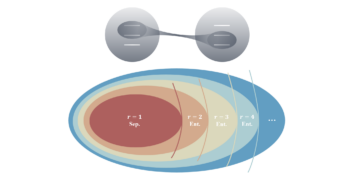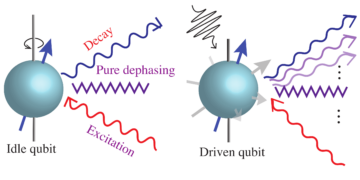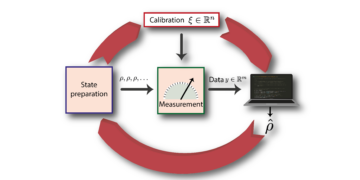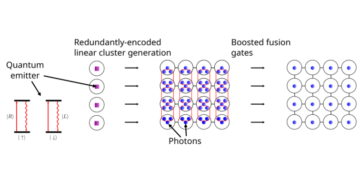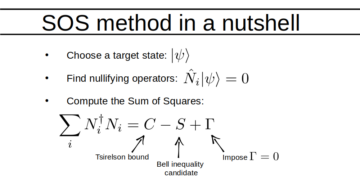
1The Abdus Salam International Centre for Theoretical Physics (ICTP), Strada Costiera 11, 34151 Trieste, Italy
2International School for Advanced Studies (SISSA), via Bonomea 265, 34136 Trieste, Italy
3INFN, Sezione di Trieste, Via Valerio 2, 34127 Trieste, Italy
4TCM Group, Cavendish Laboratory, University of Cambridge, Cambridge CB3 0HE, UK
Find this paper interesting or want to discuss? Scite or leave a comment on SciRate.
Abstract
Magic is a property of a quantum state that characterizes its deviation from a stabilizer state, serving as a useful resource for achieving universal quantum computation e.g., within schemes that use Clifford operations. In this work, we study magic, as quantified by the stabilizer Renyi entropy, in a class of models known as generalized Rokhsar-Kivelson systems, i.e., Hamiltonians that allow a stochastic matrix form (SMF) decomposition. The ground state wavefunctions of these systems can be written explicitly throughout their phase diagram, and their properties can be related to associated classical statistical mechanics problems, thereby allowing powerful analytical and numerical approaches that are not usually available in conventional quantum many body settings. As a result, we are able to express the SRE in terms of wave function coefficients that can be understood as a free energy difference of related classical problems. We apply this insight to a range of quantum many body SMF Hamiltonians, which affords us to study numerically the SRE of large high-dimensional systems, and in some cases to obtain analytical results. We observe that the behaviour of the SRE is relatively featureless across quantum phase transitions in these systems, although it is indeed singular (in its first or higher order derivative, depending on the nature of the transition). On the contrary, we find that the maximum of the SRE generically occurs at a cusp away from the quantum critical point, where the derivative suddenly changes sign. Furthermore, we compare the SRE and the logarithm of overlaps with specific stabilizer states, asymptotically realised in the ground state phase diagrams of these systems. We find that they display strikingly similar behaviors, which in turn establish rigorous bounds on the min-relative entropy of magic.
Popular summary
The study reveals some surprising findings. While magic seems to be present throughout these systems, it doesn’t necessarily peak at critical points where we would think that the system becomes particularly complex. Instead, it reaches a maximum at a different point, that doesn’t seem to be related to any critical behavior.
► BibTeX data
► References
[1] Daniel Gottesman. “Stabilizer codes and quantum error correction” (1997). arXiv:quant-ph/9705052.
arXiv:quant-ph/9705052
[2] Michael A. Nielsen and Isaac L. Chuang. “Quantum computation and quantum information”. Cambridge University Press. (2012).
https://doi.org/10.1017/cbo9780511976667
[3] V. Vedral, M. B. Plenio, M. A. Rippin, and P. L. Knight. “Quantifying entanglement”. Phys. Rev. Lett. 78, 2275–2279 (1997).
https://doi.org/10.1103/PhysRevLett.78.2275
[4] Ryszard Horodecki, Paweł Horodecki, Michał Horodecki, and Karol Horodecki. “Quantum entanglement”. Rev. Mod. Phys. 81, 865–942 (2009).
https://doi.org/10.1103/RevModPhys.81.865
[5] Graeme Smith and Debbie Leung. “Typical entanglement of stabilizer states”. Phys. Rev. A 74, 062314 (2006).
https://doi.org/10.1103/PhysRevA.74.062314
[6] J. Gütschow. “Entanglement generation of clifford quantum cellular automata”. Applied Physics B 98, 623–633 (2009).
https://doi.org/10.1007/s00340-009-3840-1
[7] John Preskill. “Quantum computing and the entanglement frontier” (2012) arXiv:1203.5813.
arXiv:1203.5813
[8] Aram W. Harrow and Ashley Montanaro. “Quantum computational supremacy”. Nature 549, 203–209 (2017).
https://doi.org/10.1038/nature23458
[9] Daniel Gottesman. “The heisenberg representation of quantum computers” (1998). arXiv:quant-ph/9807006.
arXiv:quant-ph/9807006
[10] Daniel Gottesman. “Theory of fault-tolerant quantum computation”. Phys. Rev. A 57, 127–137 (1998).
https://doi.org/10.1103/PhysRevA.57.127
[11] Scott Aaronson and Daniel Gottesman. “Improved simulation of stabilizer circuits”. Phys. Rev. A 70, 052328 (2004).
https://doi.org/10.1103/PhysRevA.70.052328
[12] Sergey Bravyi and Alexei Kitaev. “Universal quantum computation with ideal Clifford gates and noisy ancillas”. Phys. Rev. A 71, 022316 (2005).
https://doi.org/10.1103/PhysRevA.71.022316
[13] Earl T. Campbell, Barbara M. Terhal, and Christophe Vuillot. “Roads towards fault-tolerant universal quantum computation”. Nature 549, 172–179 (2017).
https://doi.org/10.1038/nature23460
[14] Sergey Bravyi and Jeongwan Haah. “Magic-state distillation with low overhead”. Phys. Rev. A 86, 052329 (2012).
https://doi.org/10.1103/PhysRevA.86.052329
[15] Eric Chitambar and Gilad Gour. “Quantum resource theories”. Rev. Mod. Phys. 91, 025001 (2019).
https://doi.org/10.1103/RevModPhys.91.025001
[16] Sergey Bravyi and David Gosset. “Improved classical simulation of quantum circuits dominated by clifford gates”. Phys. Rev. Lett. 116, 250501 (2016).
https://doi.org/10.1103/PhysRevLett.116.250501
[17] Sergey Bravyi, Graeme Smith, and John A. Smolin. “Trading classical and quantum computational resources”. Phys. Rev. X 6, 021043 (2016).
https://doi.org/10.1103/PhysRevX.6.021043
[18] Mark Howard and Earl Campbell. “Application of a resource theory for magic states to fault-tolerant quantum computing”. Physical Review Letters 118 (2017).
https://doi.org/10.1103/physrevlett.118.090501
[19] Markus Heinrich and David Gross. “Robustness of magic and symmetries of the stabiliser polytope”. Quantum 3, 132 (2019).
https://doi.org/10.22331/q-2019-04-08-132
[20] James R. Seddon, Bartosz Regula, Hakop Pashayan, Yingkai Ouyang, and Earl T. Campbell. “Quantifying quantum speedups: Improved classical simulation from tighter magic monotones”. PRX Quantum 2, 010345 (2021).
https://doi.org/10.1103/PRXQuantum.2.010345
[21] Hiroki Hamaguchi, Kou Hamada, and Nobuyuki Yoshioka. “Handbook for efficiently quantifying robustness of magic” (2023). arXiv:2311.01362.
arXiv:2311.01362
[22] Lorenzo Leone, Salvatore F. E. Oliviero, and Alioscia Hamma. “Stabilizer rényi entropy”. Phys. Rev. Lett. 128, 050402 (2022).
https://doi.org/10.1103/PhysRevLett.128.050402
[23] Zi-Wen Liu and Andreas Winter. “Many-body quantum magic”. PRX Quantum 3, 020333 (2022).
https://doi.org/10.1103/PRXQuantum.3.020333
[24] Christopher David White, ChunJun Cao, and Brian Swingle. “Conformal field theories are magical”. Phys. Rev. B 103, 075145 (2021).
https://doi.org/10.1103/PhysRevB.103.075145
[25] S Sarkar, C Mukhopadhyay, and A Bayat. “Characterization of an operational quantum resource in a critical many-body system”. New Journal of Physics 22, 083077 (2020).
https://doi.org/10.1088/1367-2630/aba919
[26] Salvatore F. E. Oliviero, Lorenzo Leone, and Alioscia Hamma. “Magic-state resource theory for the ground state of the transverse-field ising model”. Phys. Rev. A 106, 042426 (2022).
https://doi.org/10.1103/PhysRevA.106.042426
[27] Jovan Odavić, Tobias Haug, Gianpaolo Torre, Alioscia Hamma, Fabio Franchini, and Salvatore Marco Giampaolo. “Complexity of frustration: A new source of non-local non-stabilizerness”. SciPost Physics 15 (2023).
https://doi.org/10.21468/scipostphys.15.4.131
[28] Tobias Haug and Lorenzo Piroli. “Quantifying nonstabilizerness of matrix product states”. Phys. Rev. B 107, 035148 (2023).
https://doi.org/10.1103/PhysRevB.107.035148
[29] Tobias Haug and Lorenzo Piroli. “Stabilizer entropies and nonstabilizerness monotones”. Quantum 7, 1092 (2023).
https://doi.org/10.22331/q-2023-08-28-1092
[30] Guglielmo Lami and Mario Collura. “Nonstabilizerness via perfect pauli sampling of matrix product states”. Phys. Rev. Lett. 131, 180401 (2023).
https://doi.org/10.1103/PhysRevLett.131.180401
[31] Poetri Sonya Tarabunga, Emanuele Tirrito, Titas Chanda, and Marcello Dalmonte. “Many-body magic via pauli-markov chains—from criticality to gauge theories”. PRX Quantum 4, 040317 (2023).
https://doi.org/10.1103/PRXQuantum.4.040317
[32] Poetri Sonya Tarabunga. “Critical behaviours of non-stabilizerness in quantum spin chains” (2023). arXiv:2309.00676.
arXiv:2309.00676
[33] Poetri Sonya Tarabunga, Emanuele Tirrito, Mari Carmen Bañuls, and Marcello Dalmonte. “Nonstabilizerness via matrix product states in the pauli basis” (2024). arXiv:2401.16498.
arXiv:2401.16498
[34] M. Frau, P. S. Tarabunga, M. Collura, M. Dalmonte, and E. Tirrito. “Non-stabilizerness versus entanglement in matrix product states” (2024). arXiv:2404.18768.
arXiv:2404.18768
[35] Junjie Chen, Yuxuan Yan, and You Zhou. “Magic of quantum hypergraph states” (2023). arXiv:2308.01886.
arXiv:2308.01886
[36] Salvatore F. E. Oliviero, Lorenzo Leone, Alioscia Hamma, and Seth Lloyd. “Measuring magic on a quantum processor”. npj Quantum Information 8, 148 (2022).
https://doi.org/10.1038/s41534-022-00666-5
[37] Tobias Haug and M.S. Kim. “Scalable measures of magic resource for quantum computers”. PRX Quantum 4, 010301 (2023).
https://doi.org/10.1103/PRXQuantum.4.010301
[38] Tobias Haug, Soovin Lee, and M. S. Kim. “Efficient stabilizer entropies for quantum computers” (2023). arXiv:2305.19152.
arXiv:2305.19152
[39] Emanuele Tirrito, Poetri Sonya Tarabunga, Gugliemo Lami, Titas Chanda, Lorenzo Leone, Salvatore F. E. Oliviero, Marcello Dalmonte, Mario Collura, and Alioscia Hamma. “Quantifying nonstabilizerness through entanglement spectrum flatness”. Physical Review A 109 (2024).
https://doi.org/10.1103/physreva.109.l040401
[40] Xhek Turkeshi, Marco Schirò, and Piotr Sierant. “Measuring nonstabilizerness via multifractal flatness”. Phys. Rev. A 108, 042408 (2023).
https://doi.org/10.1103/PhysRevA.108.042408
[41] Luigi Amico, Rosario Fazio, Andreas Osterloh, and Vlatko Vedral. “Entanglement in many-body systems”. Rev. Mod. Phys. 80, 517–576 (2008).
https://doi.org/10.1103/RevModPhys.80.517
[42] J. Eisert, M. Cramer, and M. B. Plenio. “Colloquium: Area laws for the entanglement entropy”. Rev. Mod. Phys. 82, 277–306 (2010).
https://doi.org/10.1103/RevModPhys.82.277
[43] Ning Bao, ChunJun Cao, and Vincent Paul Su. “Magic state distillation from entangled states”. Phys. Rev. A 105, 022602 (2022).
https://doi.org/10.1103/PhysRevA.105.022602
[44] C L Henley. “From classical to quantum dynamics at rokhsar–kivelson points”. Journal of Physics: Condensed Matter 16, S891–S898 (2004).
https://doi.org/10.1088/0953-8984/16/11/045
[45] Eddy Ardonne, Paul Fendley, and Eduardo Fradkin. “Topological order and conformal quantum critical points”. Annals of Physics 310, 493–551 (2004).
https://doi.org/10.1016/j.aop.2004.01.004
[46] Claudio Castelnovo, Claudio Chamon, Christopher Mudry, and Pierre Pujol. “From quantum mechanics to classical statistical physics: Generalized rokhsar–kivelson hamiltonians and the “stochastic matrix form” decomposition”. Annals of Physics 318, 316–344 (2005).
https://doi.org/10.1016/j.aop.2005.01.006
[47] Stefano Piemontese, Tommaso Roscilde, and Alioscia Hamma. “Entanglement complexity of the rokhsar-kivelson-sign wavefunctions”. Phys. Rev. B 107, 134202 (2023).
https://doi.org/10.1103/PhysRevB.107.134202
[48] Daniel S. Rokhsar and Steven A. Kivelson. “Superconductivity and the quantum hard-core dimer gas”. Phys. Rev. Lett. 61, 2376–2379 (1988).
https://doi.org/10.1103/PhysRevLett.61.2376
[49] F. Verstraete, M. M. Wolf, D. Perez-Garcia, and J. I. Cirac. “Criticality, the area law, and the computational power of projected entangled pair states”. Phys. Rev. Lett. 96, 220601 (2006).
https://doi.org/10.1103/PhysRevLett.96.220601
[50] Martin Schwarz, Kristan Temme, and Frank Verstraete. “Preparing projected entangled pair states on a quantum computer”. Phys. Rev. Lett. 108, 110502 (2012).
https://doi.org/10.1103/PhysRevLett.108.110502
[51] Guo-Yi Zhu and Guang-Ming Zhang. “Gapless coulomb state emerging from a self-dual topological tensor-network state”. Phys. Rev. Lett. 122, 176401 (2019).
https://doi.org/10.1103/PhysRevLett.122.176401
[52] Jong Yeon Lee, Wenjie Ji, Zhen Bi, and Matthew P. A. Fisher. “Decoding measurement-prepared quantum phases and transitions: from ising model to gauge theory, and beyond” (2022). arXiv:2208.11699.
arXiv:2208.11699
[53] Guo-Yi Zhu, Nathanan Tantivasadakarn, Ashvin Vishwanath, Simon Trebst, and Ruben Verresen. “Nishimori’s cat: Stable long-range entanglement from finite-depth unitaries and weak measurements”. Physical Review Letters 131 (2023).
https://doi.org/10.1103/physrevlett.131.200201
[54] Edward H. Chen, Guo-Yi Zhu, Ruben Verresen, Alireza Seif, Elisa Baümer, David Layden, Nathanan Tantivasadakarn, Guanyu Zhu, Sarah Sheldon, Ashvin Vishwanath, Simon Trebst, and Abhinav Kandala. “Realizing the nishimori transition across the error threshold for constant-depth quantum circuits” (2023). arXiv:2309.02863.
arXiv:2309.02863
[55] Guo-Yi Zhu, Ji-Yao Chen, Peng Ye, and Simon Trebst. “Topological fracton quantum phase transitions by tuning exact tensor network states”. Phys. Rev. Lett. 130, 216704 (2023).
https://doi.org/10.1103/PhysRevLett.130.216704
[56] C. Castelnovo, S. Trebst, and M. Troyer. “Fractionalization and topological order”. In Understanding Quantum Phase Transitions. Pages 169–192. CRC Press (2010).
https://doi.org/10.1201/b10273-10
[57] David Gross, Sepehr Nezami, and Michael Walter. “Schur–weyl duality for the clifford group with applications: Property testing, a robust hudson theorem, and de finetti representations”. Communications in Mathematical Physics 385, 1325–1393 (2021).
https://doi.org/10.1007/s00220-021-04118-7
[58] Ulli Wolff. “Collective monte carlo updating for spin systems”. Phys. Rev. Lett. 62, 361–364 (1989).
https://doi.org/10.1103/PhysRevLett.62.361
[59] Koji Hukushima and Koji Nemoto. “Exchange monte carlo method and application to spin glass simulations”. Journal of the Physical Society of Japan 65, 1604–1608 (1996).
https://doi.org/10.1143/jpsj.65.1604
[60] E. Marinari, G. Parisi, J. Ruiz-Lorenzo, and F. Ritort. “Numerical evidence for spontaneously broken replica symmetry in 3d spin glasses”. Phys. Rev. Lett. 76, 843–846 (1996).
https://doi.org/10.1103/PhysRevLett.76.843
[61] Franz J. Wegner. “Duality in generalized ising models” (2014). arXiv:1411.5815.
arXiv:1411.5815
[62] Claudio Castelnovo and Claudio Chamon. “Quantum topological phase transition at the microscopic level”. Phys. Rev. B 77, 054433 (2008).
https://doi.org/10.1103/PhysRevB.77.054433
[63] A L Talapov and H W J Blöte. “The magnetization of the 3d ising model”. Journal of Physics A: Mathematical and General 29, 5727–5733 (1996).
https://doi.org/10.1088/0305-4470/29/17/042
[64] Hidetoshi Nishimori. “Statistical Physics of Spin Glass and Information Processing: an Introduction”. Oxford University Press. (2001).
https://doi.org/10.1093/acprof:oso/9780199227259.001.0001
[65] Anders W. Sandvik, Adolfo Avella, and Ferdinando Mancini. “Computational studies of quantum spin systems”. In AIP Conference Proceedings. AIP (2010).
[66] G. H. Wannier. “Antiferromagnetism. the triangular ising net”. Phys. Rev. 79, 357–364 (1950).
https://doi.org/10.1103/PhysRev.79.357
[67] R.M.F. Houtappel. “Order-disorder in hexagonal lattices”. Physica 16, 425–455 (1950).
https://doi.org/10.1016/0031-8914(50)90130-3
[68] Daniel Blankschtein, M. Ma, A. Nihat Berker, Gary S. Grest, and C. M. Soukoulis. “Orderings of a stacked frustrated triangular system in three dimensions”. Phys. Rev. B 29, 5250–5252 (1984).
https://doi.org/10.1103/PhysRevB.29.5250
[69] R. Moessner and S. L. Sondhi. “Ising models of quantum frustration”. Phys. Rev. B 63, 224401 (2001).
https://doi.org/10.1103/PhysRevB.63.224401
[70] S. V. Isakov and R. Moessner. “Interplay of quantum and thermal fluctuations in a frustrated magnet”. Phys. Rev. B 68, 104409 (2003).
https://doi.org/10.1103/PhysRevB.68.104409
[71] Yan-Cheng Wang, Yang Qi, Shu Chen, and Zi Yang Meng. “Caution on emergent continuous symmetry: A monte carlo investigation of the transverse-field frustrated ising model on the triangular and honeycomb lattices”. Phys. Rev. B 96, 115160 (2017).
https://doi.org/10.1103/PhysRevB.96.115160
[72] Helmut G. Katzgraber, Mathias Körner, and A. P. Young. “Universality in three-dimensional ising spin glasses: A monte carlo study”. Phys. Rev. B 73, 224432 (2006).
https://doi.org/10.1103/PhysRevB.73.224432
[73] Jonas Charfreitag, Michael Jünger, Sven Mallach, and Petra Mutzel. “McSparse: Exact solutions of sparse maximum cut and sparse unconstrained binary quadratic optimization problems”. In Cynthia A. Phillips and Bettina Speckmann, editors, 2022 Proceedings of the Symposium on Algorithm Engineering and Experiments (ALENEX). Pages 54–66. (2022).
https://doi.org/10.1137/1.9781611977042.5
[74] Alexei Kitaev. “Anyons in an exactly solved model and beyond”. Annals of Physics 321, 2–111 (2006).
https://doi.org/10.1016/j.aop.2005.10.005
[75] Claudio Castelnovo, Claudio Chamon, Christopher Mudry, and Pierre Pujol. “Zero-temperature kosterlitz–thouless transition in a two-dimensional quantum system”. Annals of Physics 322, 903–934 (2007).
https://doi.org/10.1016/j.aop.2006.04.017
[76] R. Moessner and S. L. Sondhi. “Three-dimensional resonating-valence-bond liquids and their excitations”. Phys. Rev. B 68, 184512 (2003).
https://doi.org/10.1103/PhysRevB.68.184512
[77] Michael Hermele, Matthew P. A. Fisher, and Leon Balents. “Pyrochlore photons: The $u(1)$ spin liquid in a $s=frac{1}{2}$ three-dimensional frustrated magnet”. Phys. Rev. B 69, 064404 (2004).
https://doi.org/10.1103/PhysRevB.69.064404
[78] A. H. Castro Neto, P. Pujol, and Eduardo Fradkin. “Ice: A strongly correlated proton system”. Phys. Rev. B 74, 024302 (2006).
https://doi.org/10.1103/PhysRevB.74.024302
[79] Owen Benton, Olga Sikora, and Nic Shannon. “Seeing the light: Experimental signatures of emergent electromagnetism in a quantum spin ice”. Phys. Rev. B 86, 075154 (2012).
https://doi.org/10.1103/PhysRevB.86.075154
Cited by
[1] Poetri Sonya Tarabunga, Emanuele Tirrito, Mari Carmen Bañuls, and Marcello Dalmonte, “Nonstabilizerness via matrix product states in the Pauli basis”, arXiv:2401.16498, (2024).
[2] M. Frau, P. S. Tarabunga, M. Collura, M. Dalmonte, and E. Tirrito, “Non-stabilizerness versus entanglement in matrix product states”, arXiv:2404.18768, (2024).
[3] Xhek Turkeshi, Anatoly Dymarsky, and Piotr Sierant, “Pauli Spectrum and Magic of Typical Quantum Many-Body States”, arXiv:2312.11631, (2023).
[4] Mircea Bejan, Campbell McLauchlan, and Benjamin Béri, “Dynamical Magic Transitions in Monitored Clifford+T Circuits”, arXiv:2312.00132, (2023).
[5] Gianluca Passarelli, Rosario Fazio, and Procolo Lucignano, “Nonstabilizerness of Permutationally Invariant Systems”, arXiv:2402.08551, (2024).
[6] Jordi Arnau Montañà López and Pavel Kos, “Exact solution of long-range stabilizer Rényi entropy in the dual-unitary XXZ model”, arXiv:2405.04448, (2024).
The above citations are from SAO/NASA ADS (last updated successfully 2024-05-14 13:04:57). The list may be incomplete as not all publishers provide suitable and complete citation data.
Could not fetch Crossref cited-by data during last attempt 2024-05-14 13:04:55: Could not fetch cited-by data for 10.22331/q-2024-05-14-1347 from Crossref. This is normal if the DOI was registered recently.
This Paper is published in Quantum under the Creative Commons Attribution 4.0 International (CC BY 4.0) license. Copyright remains with the original copyright holders such as the authors or their institutions.
- SEO Powered Content & PR Distribution. Get Amplified Today.
- PlatoData.Network Vertical Generative Ai. Empower Yourself. Access Here.
- PlatoAiStream. Web3 Intelligence. Knowledge Amplified. Access Here.
- PlatoESG. Carbon, CleanTech, Energy, Environment, Solar, Waste Management. Access Here.
- PlatoHealth. Biotech and Clinical Trials Intelligence. Access Here.
- Source: https://quantum-journal.org/papers/q-2024-05-14-1347/
- :is
- :not
- :where
- ][p
- 001
- 01
- 1
- 10
- 107
- 11
- 116
- 118
- 12
- 127
- 13
- 130
- 14
- 15%
- 16
- 17
- 19
- 1996
- 1998
- 2%
- 20
- 2001
- 2005
- 2006
- 2007
- 2008
- 2009
- 2010
- 2012
- 2014
- 2016
- 2017
- 2019
- 2020
- 2021
- 2022
- 2023
- 2024
- 21
- 22
- 23
- 24
- 25
- 26
- 27
- 28
- 29
- 30
- 31
- 32
- 321
- 33
- 34
- 35%
- 36
- 361
- 37
- 385
- 39
- 3d
- 4
- 40
- 41
- 42
- 45
- 46
- 48
- 49
- 5
- 50
- 51
- 52
- 53
- 54
- 55
- 58
- 6
- 60
- 62
- 65
- 66
- 67
- 69
- 7
- 70
- 72
- 73
- 74
- 75
- 77
- 8
- 80
- 9
- 91
- 98
- a
- Able
- above
- ABSTRACT
- access
- achieving
- across
- advanced
- affiliations
- aip
- algorithm
- alireza
- All
- allow
- Allowing
- also
- Although
- an
- Analytical
- analyze
- and
- any
- Application
- applications
- applied
- Apply
- approaches
- ARE
- AREA
- AS
- associated
- asymptotically
- At
- attempt
- author
- authors
- available
- away
- b
- basis
- BE
- becomes
- behavior
- behaviors
- behaviour
- behaviours
- Benjamin
- Beyond
- binary
- body
- bounds
- Break
- Brian
- Broken
- build
- by
- called
- cambridge
- campbell
- CAN
- cao
- cases
- CAT
- cellular
- centre
- chains
- Changes
- characterizes
- chen
- Christopher
- circuits
- class
- Codes
- coefficients
- comment
- Commons
- Communications
- compare
- complete
- complex
- complexity
- computation
- computational
- computational power
- computer
- computers
- computing
- Condensed matter
- Conference
- continuous
- contrary
- conventional
- Cool
- copyright
- correlated
- could
- CRC
- critical
- criticality
- Cusp
- Cut
- Daniel
- data
- David
- de
- Debbie
- Den
- Depending
- derivative
- described
- deviation
- diagram
- diagrams
- difference
- different
- dimensions
- discuss
- Display
- doesn
- dominated
- during
- dynamics
- e
- editors
- Edward
- efficiently
- emerging
- energy
- Engineering
- entanglement
- eric
- error
- establish
- Ether (ETH)
- evidence
- exact
- exactly
- experimental
- experiments
- explicitly
- explores
- express
- field
- Find
- findings
- First
- fluctuations
- For
- form
- frank
- Free
- from
- Frontier
- frustrated
- frustration
- function
- Furthermore
- Gary
- GAS
- Gates
- gauge
- General
- generalized
- generation
- gilad
- glass
- glasses
- gross
- Ground
- Group
- harvard
- henley
- higher
- holders
- How
- howard
- HTTPS
- i
- ICE
- ideal
- if
- impossible
- improved
- in
- indeed
- information
- ingredient
- insight
- instead
- institutions
- interesting
- International
- Introduction
- investigation
- IT
- ITS
- james
- Japan
- JavaScript
- John
- journal
- Key
- Kim
- Knight
- known
- laboratory
- large
- Last
- Law
- Laws
- Leave
- Lee
- Level
- License
- light
- Liquid
- List
- logarithm
- Low
- magic
- magnet
- many
- marcello
- Marco
- Mario
- mark
- Martin
- mathematical
- Matrix
- Matter
- matthew
- maximum
- May..
- measurements
- measures
- mechanics
- method
- methods
- Michael
- microscopic
- model
- models
- monitored
- Month
- Nature
- necessarily
- net
- network
- New
- normal
- numerical
- observe
- obtain
- of
- on
- ONE
- open
- operational
- Operations
- optimization
- or
- order
- original
- overhead
- Oxford
- oxford university
- pages
- pair
- Paper
- particularly
- Paul
- Peak
- perfect
- phase
- phases
- Photons
- physical
- Physics
- Pierre
- plato
- Plato Data Intelligence
- PlatoData
- Point
- points
- power
- powerful
- powerful tools
- present
- press
- problems
- Proceedings
- processing
- Processor
- Product
- projected
- properties
- property
- provide
- published
- publisher
- publishers
- Qi
- quadratic
- quantified
- Quantum
- Quantum Computer
- quantum computers
- quantum computing
- quantum error correction
- quantum information
- Quantum Mechanics
- quest
- R
- range
- Reaches
- recently
- references
- registered
- related
- relatively
- remains
- replica
- representation
- representations
- research
- resource
- Resources
- result
- Results
- Reveals
- review
- rigorous
- robust
- robustness
- s
- schemes
- School
- Schwarz
- scott
- scott aaronson
- seem
- seems
- serving
- settings
- shannon
- sign
- Signatures
- similar
- Simon
- simulation
- simulations
- singular
- smith
- Society
- solution
- Solutions
- SOLVE
- some
- Source
- sparse
- specific
- Spectrum
- Spin
- stable
- stacked
- State
- state-of-the-art
- States
- statistical
- steven
- strongly
- studies
- Study
- Successfully
- such
- suitable
- surprising
- symmetry
- Symposium
- system
- Systems
- T
- terms
- Testing
- that
- The
- The Area
- their
- Them
- theorem
- theoretical
- theory
- thereby
- thermal
- These
- they
- thing
- Think
- this
- three
- three-dimensional
- threshold
- Through
- throughout
- tighter
- Title
- to
- tools
- towards
- transition
- transitions
- tuning
- TURN
- typical
- under
- understanding
- understood
- Universal
- university
- university of cambridge
- updated
- updating
- URL
- us
- use
- useful
- using
- usually
- Versus
- via
- vincent
- volume
- W
- wang
- want
- was
- Wave
- ways
- we
- which
- while
- white
- Winter
- with
- within
- Wolf
- Work
- would
- written
- X
- ye
- year
- you
- young
- zephyrnet
- zhang




